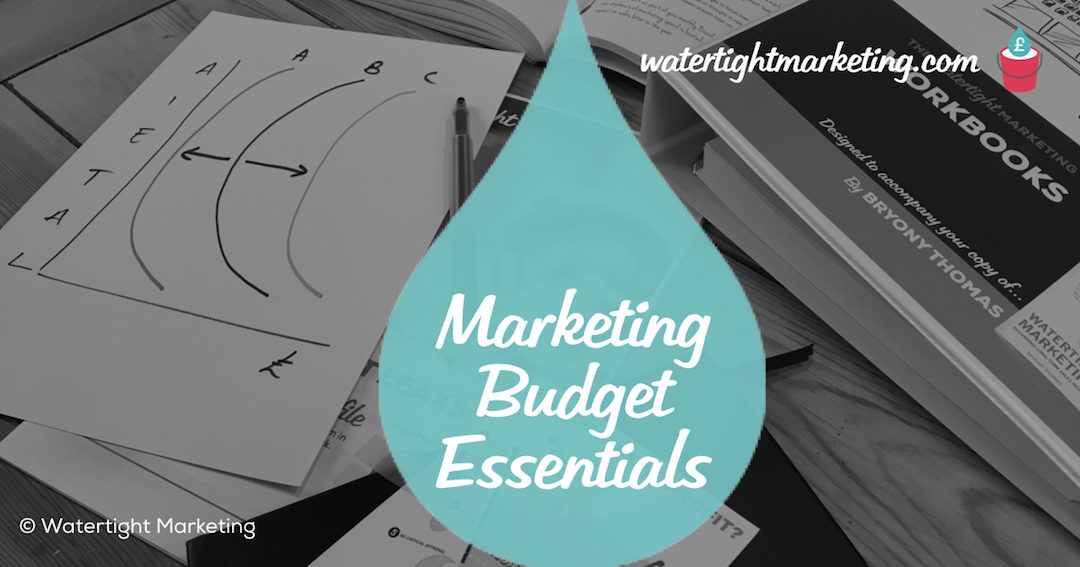So, it’s that time of year… for many the end of the tax year also closes the financial year, and means preparing a fresh 12-month marketing budget for the year ahead.
Or does it?
Many of the small businesses we encounter have an ad hoc approach to marketing expenditure – simply responding to marketing opportunities as they come along, deciding at that moment whether they have the funds available.
Whether you’re spending £100 or £1m, I firmly believe that having some structure to where you put each penny will help you to:
- Make sensible decisions about where to spend your money.
- Track whether your spend is worth it in the long term.
- Avoid nasty surprises in the form of unexpected costs.
- Ensure you don’t run out of cash half way through the year.
The Watertight Marketing approach to budgeting looks at marketing spend from three angles. The first is in allocating appropriate spend to each step of the buying decision to make sure you support every step of the sale. The second is in working out your minimum baseline, and lastly making sure you can be flexible and responsive to changes.
1) Map your marketing budget to the buying decision
My previous post ‘What shape is your marketing budget‘ looked at where to focus marketing spending in terms of the buying decision, depending on the type of purchase or product maturity. You can work out the right shape for your strategy, using the unique Watertight Marketing six step process for generating a visual snapshot of your marketing expenditure. This is a powerful planning approach gives you a stepping stone that takes someone from initial awareness right through to profitable loyalty. By looking at what task each marketing technique fulfils, and the level of influence it has at each step of the process, you end up with a template for apportioning your marketing money across the whole buying decision. This is the first step to structuring an effective marketing budget for your small business.
2) Establish your baseline
Regular readers will know that I bang on ditching the yo-yo marketing diet. If you market yourself in peaks and troughs, your business will have the same stop-start rhythm to it. Not only is this approach exhausting, it’s wasteful and ineffective. You’re much better off to establish a baseline set of marketing activities that you undertake consistently. Things that will happen, come what may. I’d go so far as to say that I’d rather most businesses spent less on marketing, if they only did so consistently. Marketing is like exercise, it pays off most if you take a little and often approach (rather than binge and purge). So, there are three things to consider when establishing your baseline:
- How much can you afford to spend every month for a year?
Whilst larger businesses might have the luxury of a more strategic approach to budgeting, in a small business setting, working out what you know you can commit to spend every month is a good starting point. As a rule of thumb, across the few hundred businesses I’ve encountered in my marketing career, 3% of revenue is about what companies spend to maintain market share, and 5% of targeted revenue is a sensible marketing budget if you’re going for growth.
- What’s the B level spend for each step?
Having undertaken the budget shaping exercise (above), we’ll typically look at each step in the buying process and work out an A (Gold) / B (Silver) / C (Bronze) pricing level for each one. By which I mean, what’s the luxury, middle, and basic version of each technique.
Let’s take PR as an example. Bronze is you buying a book on PR and putting aside a day per quarter to generate some press coverage; ideal might be retaining the services of a freelance PR expert one day per month; and, the luxury approach might be upping that time and supplementing with regular original research to generate your own headlines. For case studies, bronze might be a simple write up on your website; silver might be a professional video with your client; and, gold might be a high profile speaking event at which your client shares the stage with you.
Once you’ve worked this out for the techniques that you’ve selected to support your sales process, I’d suggest you go for B if you can. This gives you a baseline for your marketing activity.
- Make allowances for maintenance
Most nasty surprises can be avoided with a little bit of forethought. When it comes to marketing budgets, a key area that people forget is in maintaining things like their brand, website, event material, printed stock, etc. Of these, I’d say brand and websites are the biggest culprits. Often a business feels that they’ve ticked this job off. Let’s say you have a new website built in one financial year, you’d be naive to think you’ll never need to spend money on it again. Foundation pieces in a marketing toolkit (brand, website, database, collateral, etc.) should be treated a bit like an employee (with a salary, training budgets) – you’ll need to nurture and maintain them to keep them well-oiled.
3) Pre-plan some flexibility
There’s nothing more predictable than the fact that there will be things you can’t anticipate. So, plan for it. There are two key ways of doing this:
- Have a contingency budget
Put aside an affordable amount for unplanned expenses or opportunities. Interestingly, it’s the opportunities this really matters for. Most small businesses will find money for an emergency if they really need to. But, having a pot of cash to dip into to maximise on a marketing opportunity is never urgent, so is less likely to actually happen. Things will come up, like an ‘issues jump’ in PR, or a great event you hadn’t spotted. And, if not, you can always put the money towards a really innovative Christmas campaign at the end of the year.
- What’s the step up or step down?
You’ve already done the hard part on this by working out ABC options. This means that if you’re above or below target in terms of income you can change tack to the lower or higher level alternative.
With our clients, we call this this the A, B, C activity plan. Each quarter, we review our cash position to decide which plan we go with for the quarter ahead. This maintains marketing momentum, whilst flexing the budget. If you don’t have this to hand, you’ll often find that an arbitrary decision is taken to cut something at about the level you need to save – which can leave you with a hole in your sales funnel. Or, conversely, if you find that pot of gold, you can end up doing something frivolous, rather than powerfully augmenting what you’re already doing.
So, there it is… the Watertight Marketing run-down of the three key considerations when structuring an effective small business marketing budget. I hope you find it useful for the financial year ahead.
© Bryony Thomas – The Watertight Marketer

Bryony Thomas
Author & Founder, Watertight Marketing
Bryony Thomas is the creator of the multi-award winning Watertight Marketing methodology, captured in her best-selling book of the same name. She is one of the UK's foremost marketing thinkers, featured by the likes of Forbes, The Guardian, Business Insider and many more, and in-demand speaker for business conferences, in-house sales days and high-level Board strategy days.


